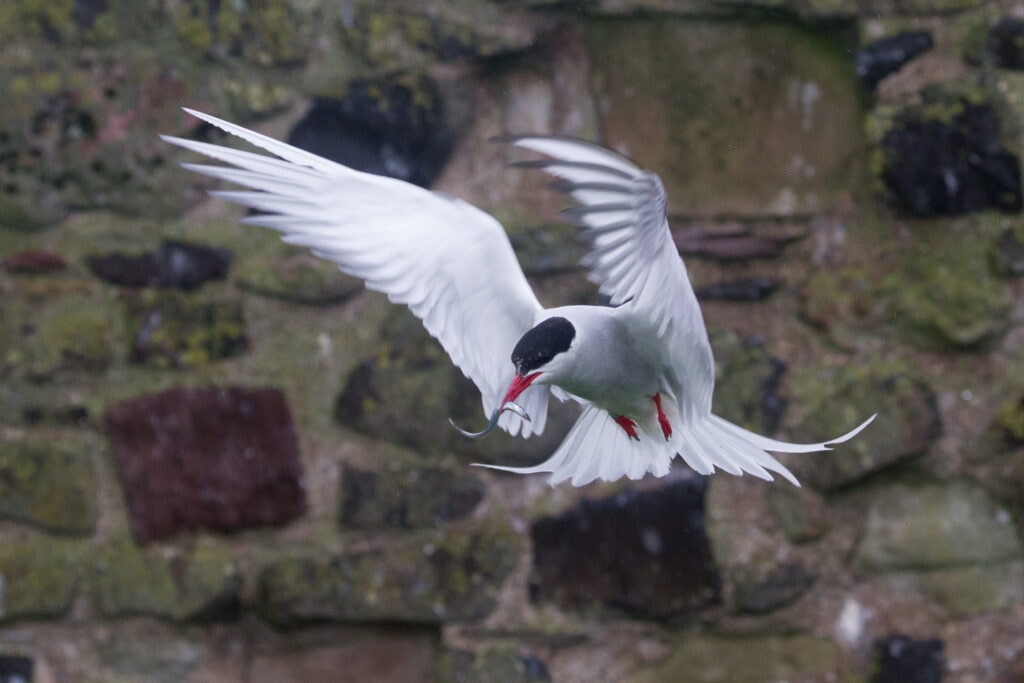Migration is a big undertaking for any animal. Each year flocks of birds cover thousands upon thousands of miles as they follow the changing seasons to the region that has the most to offer them at a given time. For some birds, migration is a relatively short jaunt to the immediate north or south, but for many more it is an enormous cross-country journey that spans national borders and sometimes even entire oceans. Amongst migrating birds, there is nobody with a journey quite like that of the Arctic Tern.
Arctic Terns are sleek gray seabirds with angular wings, black caps, and large red bills. Even to an uninitiated observer, they appear to be built for aerodynamic flight. What an observer may not guess, however, is just how ling that flight can be. Arctic Terns migrate from their Arctic breeding grounds all the way to Antarctica where they spend the summer. This pole-to-pole migration constitutes about 25,000 miles of travel and is the longest migration of any animal on planet earth.
Related Article: Flaco the Owl is New York’s Favorite Fugitive
Fun Facts About the Arctic Tern
The Arctic Tern is nature’s most extreme migrator. Let’s take a look at some Arctic Tern fun facts to learn more about what makes this unique seabird so remarkable!
Growing up on the wing: A 25,000 mile journey might seem like the kind of challenge only an experienced flyer can handle, but the Arctic Tern approach to early education is sink or swim! In fact, young chicks that begin to fledge the nest can have as little as three months to get the hang of flying before they must embark on their first migration. Banded Arctic Tern chicks have been recorded travelling from Labrador to South Africa before they’ve even hit four months of flight experience. That’s roughly 8,000 miles!
Anticipating the journey: Before setting off on their record-holding migration flights, Arctic Tern colonies, which are usually bustling with noise and activity, will fall mysteriously silent. This is often referred to as “dread.” Nobody knows why this happens, but it does add a sense of gravity to the beginning of the Arctic Tern’s arduous migration.
Racing summer: If migrating is so taxing and the birds seem to “dread” the whole process so much, then why do Arctic Terns migrate so far anyways? The answer is simple. They’re chasing summertime. When it is winter on one of the earth’s poles, the other is experiencing a summer full of long (relatively) warm days. Arctic Terns may have an easier time fishing when there is more sunlight. In any case, they spend their entire lives chasing the sun from one end of the earth to another. Over the course of their lives, it likely that the Arctic Tern spends a greater percentage of their hours in the sun than any other animal.
Half asleep: How does a bird sleep when migrating over open ocean for days, weeks, or even months at a time? It turns out that for the Arctic Tern there may be multiple solutions. Firstly, seabirds are built for the rigors of life at sea and can often easily sleep on the surface of the ocean. It is believed that Arctic Terns do sleep on the water for at least part of their journey. However, it is also widely believed that they employ a unique trick to get some rest without interrupting their flight. This is unihemispheric sleep. Unihemispheric sleep in migrating birds is a difficult concept to prove, for obvious reasons, and has not been conclusively confirmed in Arctic Terns, but there is a good chance that they do engage in this behavior. Unihemispheric sleep is the ability of an animal to sleep with one hemisphere of the brain while the other remains conscious. In migrating birds it is thought that the ability to glide on drafts of air without constantly flapping allows them to reduce their attention level and rest with half of their brains.
The Future of the Arctic Tern
The International Union for the Conservation of Nature’s Red List of Threatened Species lists the Arctic Tern as being of “Least Concern” globally. In spite of this, the Arctic Tern is currently experiencing a period of decline that conservationists find troubling. Before the establishment of the Migratory Bird Treaty Act of 1918, Arctic Terns were hunted for their feathers. Their populations have largely recovered from this practice thanks to the enactment of protections, but current numbers suggest that new threats have replaced the old. As many bird species enter an uncertain future, even nature’s most intrepid navigator faces a fraught and precarious path.
Popular Article: Species Spotlight: The Red-winged Blackbird

